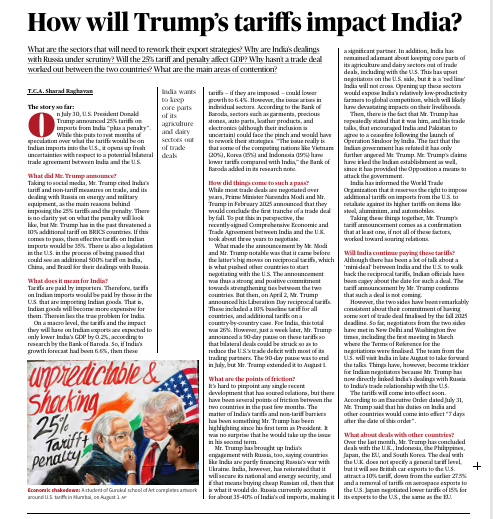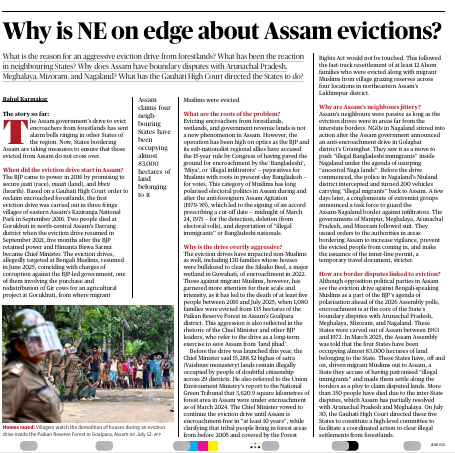Summary – How will Trump’s tariffs impact India?
1. Context
- On July 10, 2019, U.S. President Donald Trump announced a 25% “plus penalty” tariff on imports of Indian goods.
- This came amid rising tensions over India’s trade with Russia, defence procurements, and market access issues.
2. Key Issues
- S. Concerns:
- India’s energy and defence dealings with Russia.
- Market access barriers and high tariffs in India.
- Lack of concessions in bilateral trade talks.
- India’s energy and defence dealings with Russia.
- India’s Concerns:
- Tariffs hit critical exports such as steel, aluminium, and textiles.
- Pressure on domestic industries like agriculture and dairy.
- Tariffs hit critical exports such as steel, aluminium, and textiles.
3. Economic Impact
- India exports around $50 billion worth of goods to the U.S.
- Sectors like steel, aluminium, textiles, pharmaceuticals, and agriculture could face a competitiveness loss.
- Tariffs may shrink India’s GDP marginally but hurt employment and sectoral growth significantly.
4. Strategic Linkages
- The tariff move is linked to U.S. pressure on India to reduce Russian oil imports and defence purchases (e.g., S-400 missile system).
- Part of a broader U.S. strategy of using trade as leverage in geopolitical disputes, particularly the Ukraine war.
5. Policy Options for India
- Negotiation: Work towards mutual concessions, possibly reducing certain trade barriers.
- Diversification: Expand exports to other markets to reduce dependence on the U.S.
- Domestic Support: Provide relief to affected sectors.
- Strategic Balancing: Maintain Russia ties while preventing a rupture in U.S. relations.
UPSC Mains Practice Question
GS Paper 2 – International Relations
“The recent U.S. tariffs on Indian goods reflect the growing intersection of trade and geopolitics. Discuss the economic and strategic challenges for India in navigating its relationship with the U.S. amid pressure over Russia.”
Summary – Why is NE on edge about Assam evictions?
1. Context
- The Assam government has intensified eviction drives to remove “encroachments” from forest land.
- This has sparked concerns in neighbouring Northeastern states and revived debates on land, identity, and rights.
2. Eviction Background
- The BJP came to power in Assam in 2016 promising protection of land rights for locals and the clearing of forest encroachments.
- Drives have targeted people—often from marginalised communities—living on land classified as forest reserve.
- Eviction notices have led to the displacement of thousands in districts such as Sonitpur, Biswanath, and Nagaon.
3. Legal & Environmental Angle
- The state cites the Forest Conservation Act, 1980 and Supreme Court directives to justify evictions.
- However, critics argue that these measures often disregard traditional land rights, especially of indigenous groups.
- The Gauhati High Court has directed that “encroachers” must be removed from reserve forests.
- Inter-State Tensions
- Assam shares boundary disputes with Arunachal Pradesh, Meghalaya, Mizoram, and Nagaland.
- Evictions near these disputed zones have triggered tensions with neighbouring states, as residents often have ethnic ties across borders.
5. Humanitarian Concerns
- Evictions have affected livelihoods, disrupted schooling for children, and created humanitarian crises.
- Rights groups argue for rehabilitation measures and recognition of customary land rights.
6. Political Dynamics
- The eviction drives are politically sensitive, tied to identity politics and electoral promises of protecting “indigenous” land.
- Critics allege selective targeting of certain communities, fuelling mistrust among ethnic groups.
UPSC Mains Practice Question
GS Paper 2 – Polity & Governance
“Discuss the constitutional and humanitarian dimensions of eviction drives in forest areas of Northeast India, with special reference to Assam. How can the state reconcile environmental conservation with protection of indigenous rights?”



